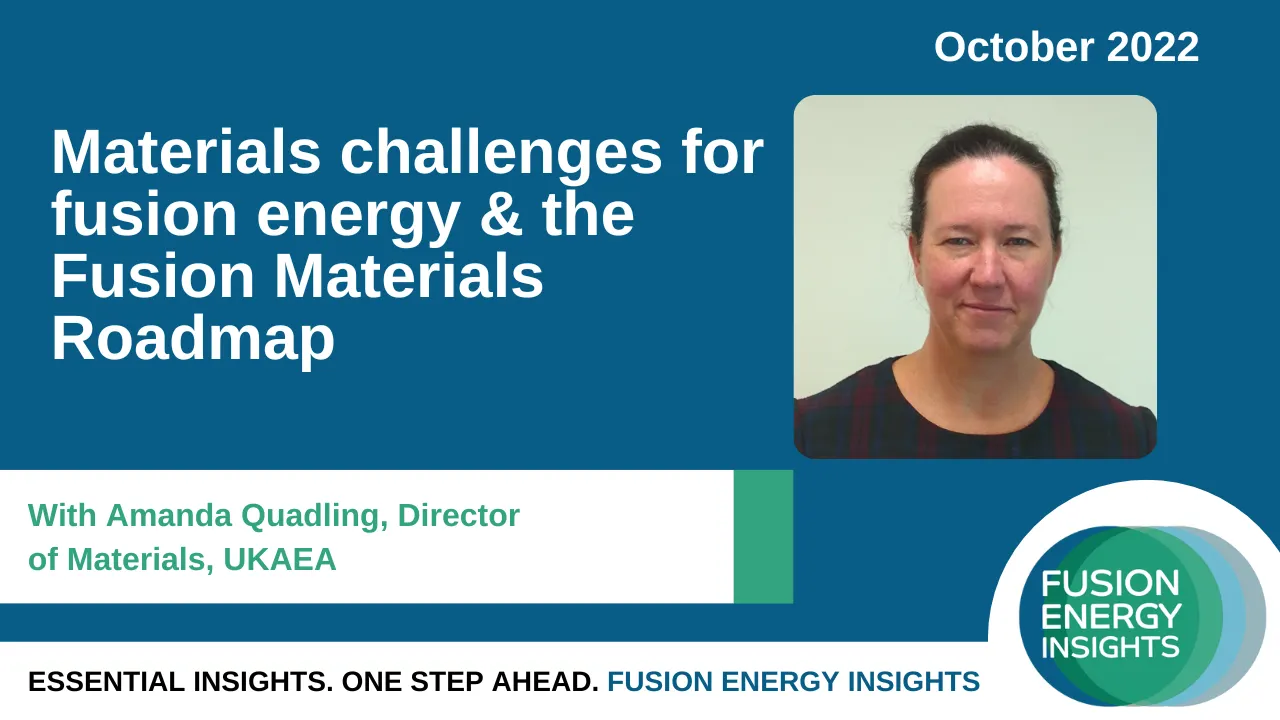Materials challenges for fusion energy & the fusion materials roadmap
On Wednesday 12th October we had an Insights Q&A session with Amanda Quadling, Director of Materials at UKAEA, talking about materials challenges for fusion energy.
Amanda made the point that fusion is entering an engineering phase so the scene is evolving fairly rapidly.

Here are three key insights from the event:
1. For fusion materials we have to deal with the triple whammy of tritium, transmutation and displacement
a) Tritium
Amanda says: “The first is that the neutron must interact with some form of lithium compounds to produce more tritium. That's the virtuous circle we're hoping for—the fuel sustainability in fusion. But it means the tritium immediately becomes part of our materials.”
The issues with this are that tritium is the fuel, so we don't want locked up in the materials, and it is a radioactive element so we don't want it moving through the balance of plant in a fusion power plant.
“At the moment, we look at materials that might be in direct contact with tritium, and how they would retain the tritium and release the tritium with temperature fluctuations.”
b) Displacement
The fusion reaction releases neutrons—neutrons with formidable amounts of energy, 14 mega electron volts (MeV).
“That energy that comes with the neutrons is fantastic for creating electricity and heat in the future. But it's such an issue for us in the material space.”
Neutrons come into a material and they knock the atoms around and displace them. The common metric is displacements per atom (DPA). It's a very good primary indicator of the degree of damage that a material suffers.
c) Transmutation
When neutrons hit atoms, neutron reactions can happen—neutrons are captured and this modifies the element. They turn into new elements, new isotopes, some of which have very long radioactive half lives.
“For fusion, we don't want those long half lives and high levels of radioactive waste. And so, if we want to prevent that, we want to work with elements on the periodic table—and the radionuclides behind them—that don't lead to long activation issues. And so that takes us away from elements that are common alloying elements in steels, for example, and limits us to very few elements on the periodic table.”
2. It is important to reduce the radioactive waste implication for fusion from an economic point of view as well as a social point of view.
Reducing the radioactive waste reduces disposal costs.
“For very low level radioactive waste, you're looking at about £1000 pounds disposal cost per cubic metre. That goes up seven times for low level waste, and seven times again for intermediate level waste. So there’s very powerful business cases, as well as social cases, for reducing the radiation levels in the waste.”
3. The field of “isotope tailoring” is going to become very interesting
An isotope is a different variety of an element. Isotopes of an element all have the same number of protons but have different numbers of neutrons and so, therefore, different masses. For example, lithium has two isotopes, lithium-6 (three protons, three neutrons) and lithium-7 (three protons, four neutrons).
Lithium-6 is the isotope of particular interest for fusion because it's the one necessary for breeding tritium. Lithium-7 is therefore the complementary isotope and, in fact, it's the one in more abundance. Many, if not most, fusion approaches will likely require lithium enriched to have greater amounts of lithium-6.
For lithium supply, there could be synergies with battery and electric vehicle (EV) industries. It’s early days, but we should be working together to think about the recycling of lithium.
Amanda says: “If we're thinking of lithium supplies that might come off the back of recycling of electric vehicle batteries, for example, could we use the lithium-six stream if there were other applications for the lithium-seven stream? Or could we work alongside EVs in only requiring the lithium-six of a component of a dual supply chain in which lithium-seven goes on to EVs and others?
“Today, to get that isotope separation, we'll need isotope tailoring mechanisms. Those would have been things like centrifuges half a century ago, but now we’ve got plasma mass separation techniques. It’s a very interesting field of study and engineering application at the moment. And I want to highlight that complementarity between fusion and adjacent sectors means we're more likely to get the supply chain right for lithium six.”
A full pdf summary of key insights, plus the Q&A event replay, is available to Game Changer members of Fusion Energy Insights. Join us now for full access to all the insights.
